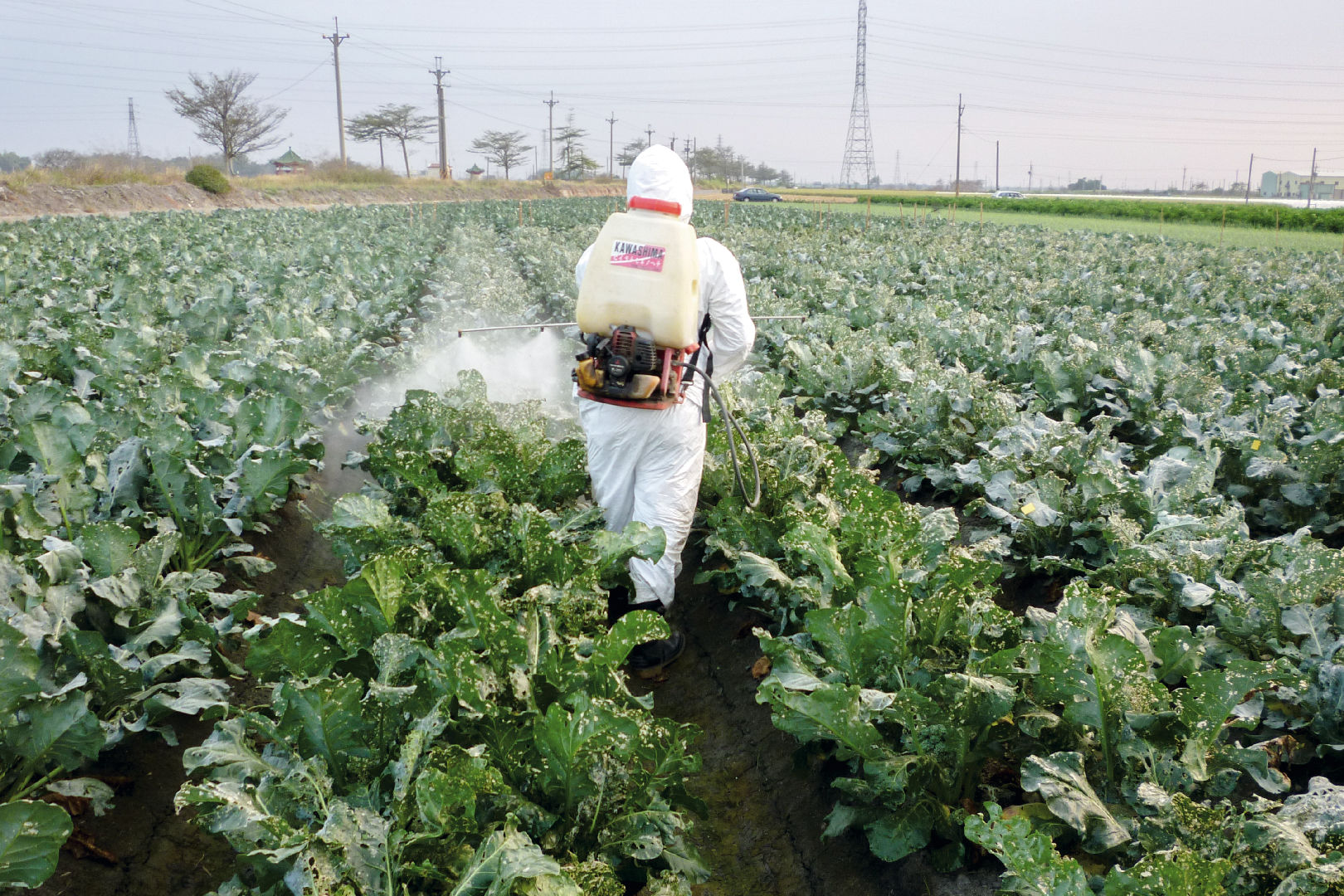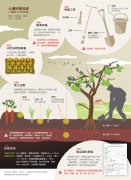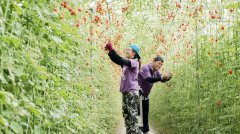Tracing back to the Source of IPM crop production Management Technology to solve the causes of Plant Diseases and insect pests
IPM is not to set the absolute method, but to find the optimal method, so let's take a look at it.
In the growth pattern of cruciferous crops, serious diseases and insect pests often occur near the harvest time. Take broccoli as an example, the sphere is covered with outer leaves, and the insect body is easy to hide, resulting in poor control results, resulting in improper timing or high frequency of drug use by farmers. makes pest management more difficult.
According to the results of pesticide monitoring and testing of agricultural products in market and packaging farms released by the Food and Drug Administration of the Ministry of Health and Welfare from 2014 to 2016, the unqualified incidence of continuous harvested crops and cruciferous crops was the highest.

In the first six years, everything went well, but in the seventh year, the situation gradually deteriorated. There were 3 or 4 pesticides exceeding the standard in one month, and there were continuous violations. Because it was impossible to trace the planting and use of drugs by farmers at that time, they had to absorb the fine on their own. At that time, it was difficult to say, and at the same time, we began to think that agricultural products must be managed by the farmers at the source before they could be safely delivered to the consumer side, rather than through back-end spot checks.
IPM is not to set the absolute method, but to find the optimal method.
Subsequently, Huang Chien-Yi and Yang Suqin actively participated in agricultural tutoring classes organized by the Yunlin County government, including organic classes and specialized classes for production and marketing curriculum vitae counsellors. At this time, they also began to come into contact with integrated pest management (Integrated Pest Management, hereinafter referred to as IPM). As a result, they got to know Yang Xiuzhu, a researcher at the Agricultural Drug and Toxicology Laboratory of the Agricultural Commission of the Executive Yuan at that time.
Nongwei Fruit and vegetable Co., Ltd. currently takes cucumbers as its main products, which are supplied by more than 20 farmers. All cucumbers are cultivated in protected facilities, and through the tutoring of Huang Qianyi and Yang Suqin, farmers have gradually adopted IPM, which is a model for the complete implementation of IPM at present. Yang Suqin said that when he began to implement IPM, he was only a counselor in a special class. Each farmer's problems were different, and he did not fully understand them.
After farmers are busy harvesting cauliflower and broccoli, they use the cultivator to beat the crop residue into the soil as the base fertilizer, emphasizing fertilizer management. This is also one of the most important IPM programs in the crop seedling stage. (photography / Xu Chongping)
There was a farmer who planted broccoli in the open air. The products on the shelves were tested to exceed the standard of pesticides. Yang Suqin immediately examined the farmers' drug use records and went to the scene to check, but did not find anything unusual, so she turned to Yang Xiuzhu for help. After the on-site investigation, it turned out that the pest control of rice in the adjacent field led to the drift of pesticides, resulting in the pollution of two rows of broccoli near the adjacent field.
Yang Xiuzhu reminded farmers to first do a good job of good neighborliness, when spraying pesticides in neighboring fields, test the drift distance of pesticides, place kitchen paper towels at a fixed distance, and observe the wetness of paper towels to judge the drift distance. After that, whenever the neighboring field is sprayed with pesticides, it is recommended to cover the crops within the drift distance with non-woven cloth, because the non-woven cloth can absorb pesticides, if the use of plastic cloth may cause a rebound, resulting in more serious pesticide drift. The farmers will follow Yang Xiuzhu's suggestion and the same problem will not occur again.
Another farmer used IPM to grow cucumbers, but there were serious diseases and insect pests and poor fruit, which led to the tragic end of this period. Huang Chien-Yi and Yang Suqin immediately asked Yang Hsiu-chu to check. It turned out that after the farmers carried out the first phase of IPM, they found that the fruit quality was very good, but the yield did not increase, so they left more fruit branches, but still maintained one bud, resulting in plant malnutrition and weakening resistance.
Yang Xiuzhu explained that the goal of IPM is not to provide the best method for all crops, but to provide the best method according to different conditions. When the cultivation conditions are different, IPM should be adjusted accordingly, not immutable. Yang Suqin said that fortunately, Yang Xiuzhu provided a complete consultation network, and when farmers had problems that were difficult to solve, he went directly to the scene to diagnose the problems and gave them the most suitable management prescription, giving them great encouragement and confidence.
The problem of cucumber actinomycosis can be disinfected before planting and controlled with pesticides during the growing period. as it is a continuous harvest crop, phosphite can be used to avoid pesticide residues during harvest. (photography / Xu Yuping)
However, not all farmers are willing to use IPM. When there is a problem, they go directly to the pesticide shop to buy pesticides. When the disease is serious, it is used twice a week, and there are as many as 10 drugs at a time. In order to improve this situation, Yang Suqin held farm observations from time to time, so that farmers could see practices different from their own farms, such as how to prevent pesticide drift pollution in neighboring fields, pesticide control of continuous harvested crops, and so on. Farmers can directly feel the difference between crop quality and farm health.
Yang Suqin mentioned that there was a novice farmer who had just begun to grow cucumbers with the usual agricultural method. Whenever he encountered diseases and insect pests, he sprayed pesticides. Although the yield was not poor, the fruit was short. Her communication with the farmers was ineffective several times, and the farmers felt that their skills were very good and their income was not low, so there was no need to adjust. Until he began to visit other farms, he found that his pesticide use was as high as 2 to 3 times, and the fruit of other cucumbers was good and long, up to 23 centimeters long, and the peel was covered with fruit powder, compared with his own cucumbers, which made the farmers convinced and willing to try using IPM.
Most farmers have gradually found that using IPM combined with production and marketing experience can indeed reduce the frequency and dosage of pesticides, make the quality better and better, and greatly reduce management costs, so they are naturally willing to change the management model. Yang Suqin said that this is also a consideration of the interests of both sides. When the crop quality is improved and the income is stable, the more farmers take the initiative to invest, the better agricultural products can be obtained by consumers.
If diseases and insect pests occur in the later stage of planting and must be sprayed with pesticides to improve them, we should also pay attention to some small details. For example, Cruciferae pests are often hidden in the leaves of the knapsack, and the spraying angle should be paid attention to when spraying, and the medicine should be sprayed on the back of the leaves or wrapped leaves. (photo / Xie Peiying)
The source of perfecting the production and marketing chain lies in caring for the health of farmers.
Despite the completion of the farmer-end integration, Yang Suqin still opened three gatekeepers to each other. The first level is "compliance with the deed regulations", with the guidance of the fruit and vegetable shops in Nongwei, correct and safe use of drugs, and a complete cultivation record; the second level is the "pesticide shop gatekeeper". In order to avoid the risk that farmers may secretly spray pesticides and buy the wrong medicine, it is suggested that farmers can purchase from several matching pesticide shops, and they can also use drug purchase records to find out whether they have violated the rules and misused them.
In addition, Yang Suqin also invited the owners of the pesticide industry to visit the farm. In addition to getting to know the farmers, they could also learn more directly about IPM from the agricultural scene.
The third level is "epidemic prevention inspection". Once agricultural products are subject to spot checks, when violations occur, they must not only share the responsibility, but also face more stringent inspection and counselling in the future. Yang Suqin said that in this process, she stood in a line with the farmers, faced and grew up together, which was a commitment to the farmers as a counselor.
Huang Qianyi and Yang Suqin have been implementing IPM for more than four years. After being verified by their production and marketing experience, they feel the gradual increase in social responsibility and deeply realize that the health of consumers is not the only health. Real health starts from caring for the health of farmers.
Through IPM, let farmers use drugs correctly, reduce the frequency and dosage of drugs, reduce farmers' exposure to risks, and reduce the burden of the ecological environment, so that the pesticide residues of agricultural products are far lower than the allowable values, which is a really healthy production and marketing chain.
The use of IPM is through problem diagnosis, prescription use, monitoring and prevention, and a series of complete countermeasures to provide effective and good protection during crop growth, and to let farmers know exactly their farming environment and crop growth status, combined with the correct concept of drug use, rather than spraying a large number of pesticides to clean up the aftermath of diseases and insect pests. Through IPM, more farmers can explore the causes of diseases and insect pests from more aspects and give the most appropriate solutions.
Through long-term counseling and concept communication, let farmers really understand the spirit of IPM and practical application, and convey the correct cultivation concept. In addition, IPM combined with production and marketing experience can also make Taiwan's fruit and vegetable cultivation process transparent and make consumers feel at ease to choose and buy.
- Prev

Soil fertility testing: how to rationalize fertilization? Analysis report on soil Fertility Grade
The promotion of rational fertilization can avoid excessive application of fertilizer and is beneficial to the sustainable use of farmland. Rational fertilization refers to farmers according to the growth characteristics of crop varieties, matching soil conditions and characteristics, types and characteristics of fertilizers, and cropping after application to the soil.
- Next

Design of Wimbledon room system: Wimbledon room has high immunity? Wimbledon rooms should be more careful against highly infectious diseases and insect pests.
Wimbledon rooms seem to avoid many diseases and insect pests, in fact, more test the usual implementation of environmental health and safety, a little turtle hair, in order to grow sweet fruit. Let's take a look at it. Biosafety is not only a necessary basis for farms and poultry farms.
Related
- A one-day flower show brings 130 million yuan in orders! Nanhai, this Phalaenopsis exhibition is amazing
- What do the flower language and meaning of Lutheran tree mean? Precautions for planting Lutheran tree
- Encounter Chaoshan Kongfu tea, not without this cup of Phoenix single clump
- The durian market in Vietnam and Thailand is flooded. The price of imported durian has plummeted by 30-40% in a month.
- Shanghai solved the problem of local vegetable supply by planting 80,000 mu of green leafy vegetables.
- Wageningen University has become the best agricultural university in the world for the seventh time in a row.
- The strongest export season of South African grapes is full of challenges, with exports to Russia falling sharply by 21%.
- Sri Lanka is on the verge of bankruptcy, "Tea for debt" Organic Agriculture Revolution aggravates the Food crisis?
- Turning waste into earthworm manure and worm manure into organic fertilizer-A new choice for auxiliary farming
- Organic rice growers shoulder the responsibility of nurturing agricultural talents! Yinchuan Sustainable Farm with Organic Life Camp

